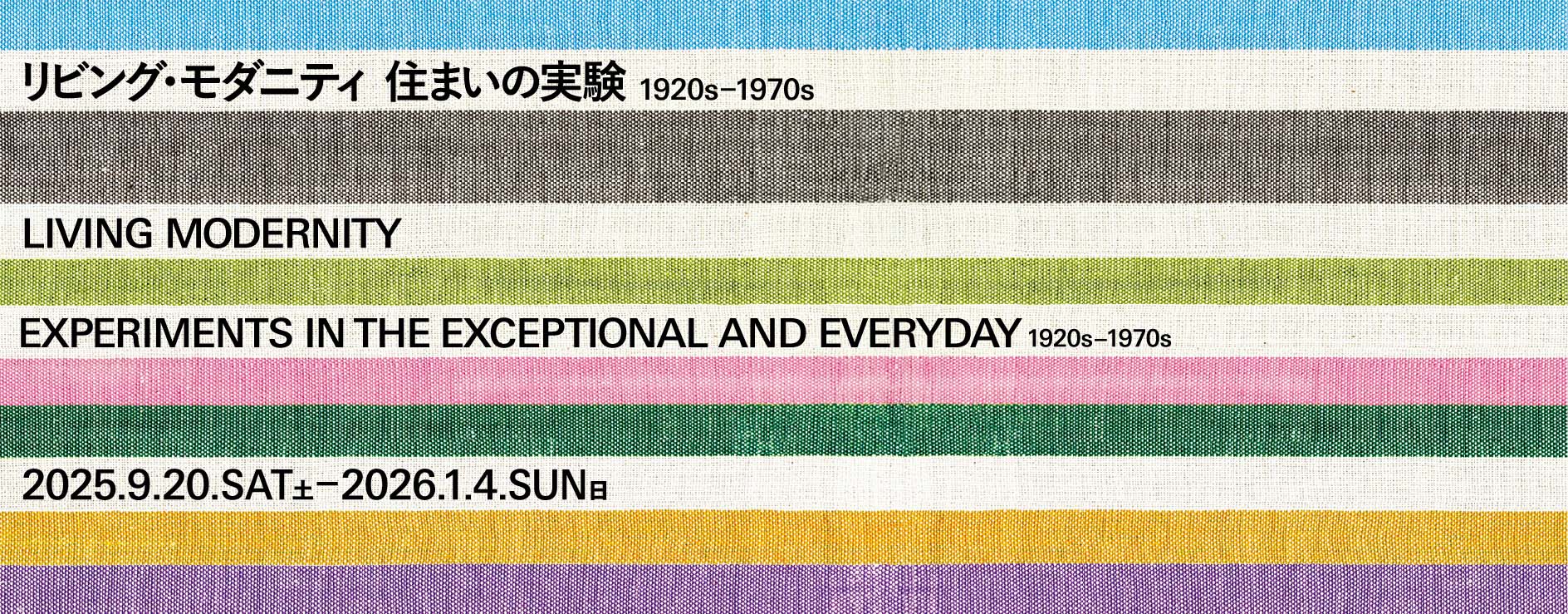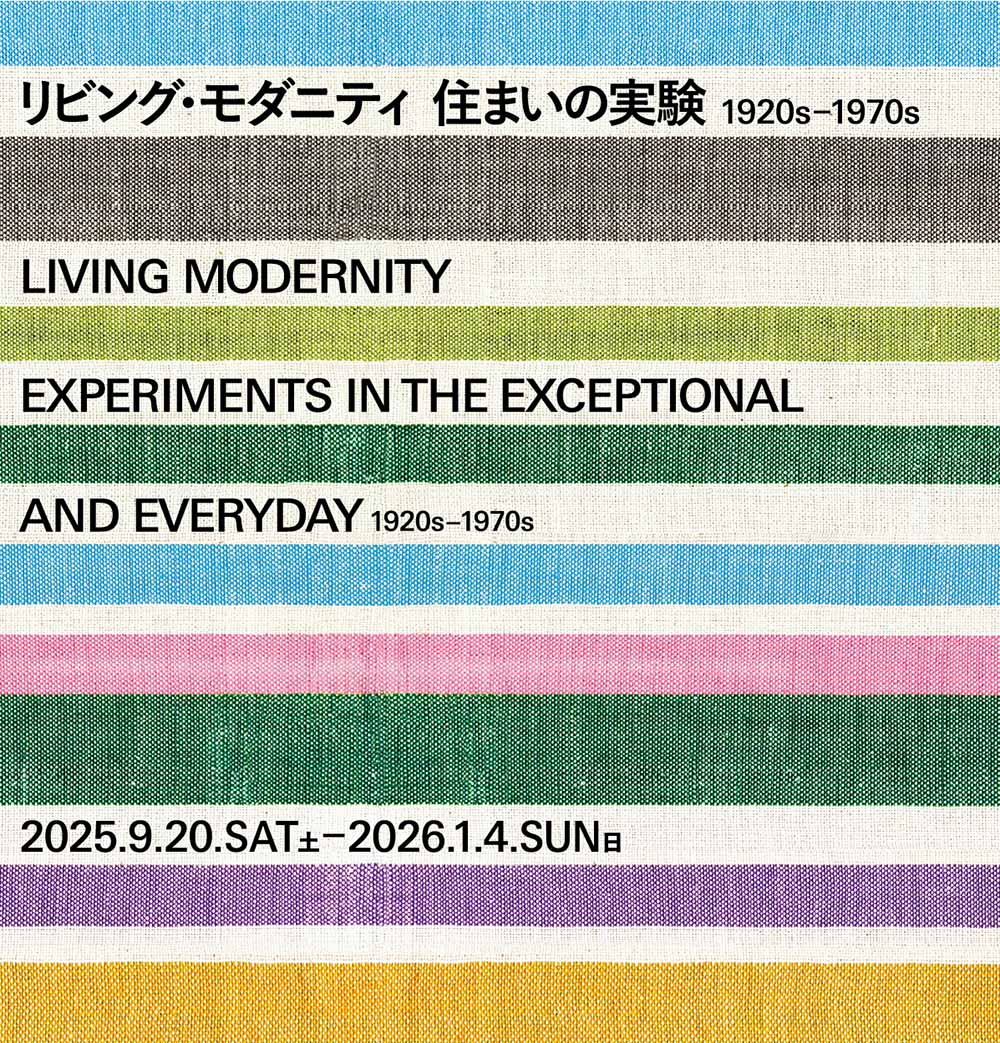

From the 1920s, architects such as Le Corbusier and Ludwig Mies van der Rohe have sought to create both functional and comfortable living spaces, employing new technologies constantly developing through time. Their exemplary experimental visions and innovative ideas eventually spread broadly to drastically transform people’s daily lives.
This exhibition entitled LIVING Modernity: Experiments in the Exceptional and Everyday 1920s-1970s showcases houses designed by architects who embraced modernity by reexamining the fundamentals of living to improve functionality, artistry and comfort. Built during the epic modern period of the 1920s to the 1970s, these houses share the international ethos of creating a new architecture fundamentally connected to their specific time, region, climate, and social context. They also vividly express the family dynamics and characters of their individual residents. Innovations in living by the architects pursuing ideal lifestyles are deeply intertwined with the distinct context of each house.
These houses were also a means to solve universal issues that have emerged in modern times. Sanitary spaces that promote personal hygiene, expansive glass windows to bring in light and breezes, kitchens to reduce household chores, furnishings such as chairs and lighting to enhance bodily comfort, and verdant landscapes brought into living spaces became key elements in defining residential architecture in the twentieth century. Iconic images of these new living spaces proliferated widely through model home exhibitions, magazines and other new media.
This exhibition reexamines these innovative aspirations in residential architecture that emerged in the twentieth century from seven perspectives that define modern houses: hygiene, materiality, windows, kitchen, furnishings, media, and landscape. Highlighting 14 residential masterpieces, the exhibition provides a multi-faceted examination of twentieth century experimental homes through photographs, drawings and sketches, models, furnishings, textiles, tableware, and magazines and graphics.
Exhibition period
September 20 (Sat.), 2025-January 4 (Sun.), 2026Closed
MondaysOpen on October 13, November 3 and 24
Opening Hours
10:00-18:00 *Last admission 30 minutes before closingVenue
Hyogo Prefectural Museum of Art→ Access
Admission (tax included)
Adults 1,800 yen / College students 1,000 yen /Over 70 years old 900 yen*Visitors who are under high school students will be admitted for free.
*Disabled people with ID booklets will have discount.
Organized by
The Hyogo Prefectural Museum of Art; Nikkei Inc.With the support of
Architectural Institute of Japan; The Japan Institute of ArchitectsWith the sponsorship of
Ito Cultural FoundationWith the cooperation of
MISAWA HOMES CO.,LTD. ; TAKENAKA CORPORATION; Shinkenchiku-sha CO.,Ltd.
With the special cooperation of
Hyogo Branch of Japan Educational Mutual Aid Association of Welfare FoundationExhibition Supervisor
Waro Kishi (Architect / Professor Emeritus, Kyoto University / Professor Emeritus, Kyoto Institute of Technology)Guest Curator
Ken Tadashi Oshima (Professor, University of Washington)Associate Curator
Kei Sasaki (Architect)Exhibition Design Support
Naoyuki Nagata (Architect / ICU Architect Office / Professor, Nara Women’s University)Art Direction
Yoshihisa Tanaka(Graphic Designer, Artist, Director of the design studio centre Inc.)As underscored by the 2020 COVID-19 pandemic, maintaining health and hygiene in confronting infectious diseases has long been one of humanity's most critical challenges. Architects in the early part of the 20th century sought to maximize natural light and ventilation to combat tuberculosis in an age of rapid urbanization and increased population density. As a starting point for modern design, the bathroom and requisite fixtures became particularly important to promote hygiene and well-being through cleanliness of the body.
In the 20th century, steel, concrete and mass-produced glass transformed the house, affording a new sense of lightness and spatial freedom. Architects embraced these material changes and rediscovered the potential of traditional materials including wood, tiles, and textiles. This exhibition highlights the ways they domesticated these materials for modern living.
Advancements in reinforced concrete construction and production of glass brought on new possibilities to liberate the wall for window openings. Unprecedented large windows afforded natural light and ventilation, as well as panoramic views from inside the home. The transformation of the window fundamentally redefined the boundary between interior and exterior, creating seamless connections between indoor and outdoor living spaces.
Modern kitchens followed developments brought on by industrial revolution. The Frankfurt Kitchen (1926) emerged based on the ethos of maximizing efficiency of space and movement in cooking at a minimal cost for some 10,000 social housing units in Frankfurt and has had global influence in the development of built-in and systematized kitchens. Cooking spaces traditionally placed at the back of the house, such a s in European basements or Japanese doma (dirt floor), shifted to brighter, more central locations near dining and living a reas and reflected the increasing prominence of the nuclear family and liberation afforded by modern appliances.
A range of design movements emerged in the 19th century in reaction against the indiscriminate replication of past styles and the overwhelming presence of low-quality mass-produced items. In the 20th century, such modern movements could be found in the Bauhaus (1919-1933) to combine crafts and fine arts while seeking to unify individual artistic vision with industrial production. Designers at the Bauhaus realized these ideals through the creation of everyday items such as textiles, metalware, lighting, and furniture. Many of the architects who sought to harmonize furnishings together with their architectural designs also themselves designed furniture and other household items. This exhibition showcases various furnishings that enriched everyday life in the 20th century from the Bauhaus and beyond based on their new aesthetic sensitivities.
Advancements in photography and modern printing technology in the 20th century afforded the development of mass media platforms of newspapers and magazines that would circulate worldwide. Architects and designers from Le Corbusier to Koji Fujii, embraced these new media to present their design ideas to the broader public audience. Housing exhibitions such as the Deutscher Werkbund exhibition in 1927, Die Wohnung (The Dwelling). promoted the modern house through direct experience. This section examines the broad range of media from books and magazines to housing exhibitions to promote ideal lifestyles to the public at large.
How can one live in harmony with the natural environment and specificities of sight within manmade spaces for living? This became a vital challenge for modern houses in the 20th century. Expansive glass windows afford the primary experience of changes through the four seasons and natural flora and fauna. Beyond the physicality of the window, these connections to the elements of light and air extend to promoting hygiene and health to restore fundamental bonds with nature suppressed through rapid modernization to contribute to one's overall well-being. How do we situate living spaces in the natural environment in harmony with the site character of the land? This exhibition thereby considers such efforts to fundamentally sustain the home in harmony with natural forces.
| 1. | Le Corbusier, Villa ≪Le Lac ≫, 1923 |
|---|---|
| 2. | Koji Fujii, Chochikukyo, 1928 |
| 3. | Mies van der Rohe, Tugendhat House, 1930 |
| 4. | Pierre Chareau, Maison de Verre, 1932 |
| 5. | Kameki Tsuchiura, Tsuchiura Kameki House, 1935 |
| 6. | Lina Bo Bardi, Casa de Vidro, 1951 |
| 7. | Kenji Hirose, SH-1, 1953 |
| 8. | Alvar Aalto, Murtala Experimental House, 1954 |
| 9. | Jean Prouve, Jean Prouve's House in Nancy, 1954 |
| 10. | Eero Saarinen, Alexander Girard, Dan Kiley, Miller House, 1957 |
| 11. | Kiyonori and Norie Kikutake, Sky House, 1958 |
| 12. | Pierre Koenig, Case Study House #22, 1960 |
| 13. | Louis Kahn, Fisher House, 1967 |
| 14. | Frank Gehry, Frank & Berta Gehry House, 1978 |

